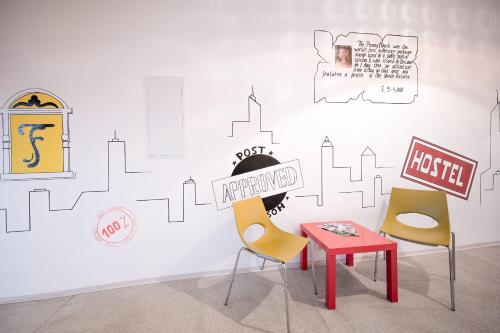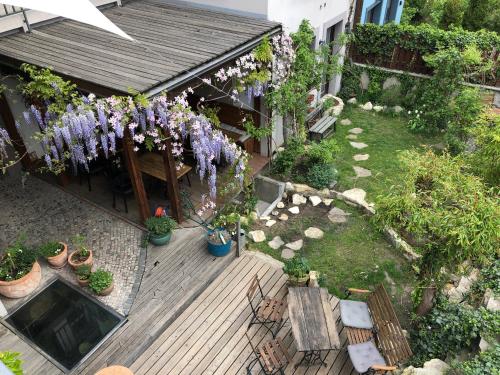I walk down the main pedestrian shopping mall of Prague, past a New Yorker shop, a United Colours of Benetton, a Zara. I turn into an entranceway next to a McDonalds and find the internal staircase up into a casino.
At the top of the stairs, a sharp turn to the left stops me heading for the gambling tables and takes me to Prague’s Museum of Communism.
It seems an odd place to be situated, surrounded by so much capitalism – most of it Western. But maybe that tells the story of communism in the city as well as anything exhibited inside.
If you look back at the twentieth century, communism had a large impact on Prague. The city was ruled by communists for 41 years, from 1948 until 1989, and it was in the Soviet sphere for several years before that.
Students of modern history could be forgiven for thinking of Prague – and the Czech Republic more generally – as having developed in the past hundred years within a prism of communist-controlled, Soviet-influence, Czechoslovakia.
The problem with that view of history is that it forgets the centuries that came before and the decades that have come since.
The Czech Republic, as I learn as I travel throughout the country, has most of its heritage in its Austrian and Hungarian past. And modern culture is defined by the period since independence and separation from Slovakia.
Those communist decades in between – they have been shrugged off and wilfully forgotten.
That’s not to say it isn’t an important part of history and it’s what has brought me to the Museum of Communism here in central Prague.
Inside the Museum of Communism
The museum is laid out on one floor and is separated into three broad sections, described as communism the dream, the reality, and the nightmare.
It has a collection of items from the period but most of the information comes from fact sheets on the walls, explaining the history and the life of the time.
As well as the politics and the economics, it talks about the role of the police and the media, the way people were censored or imprisoned.
Different areas are decorated to give a sense of the time,
There’s a classroom with books the children would’ve read on the desks…
There’s a lounge room of an average apartment with the spartan furniture of the period…
There’s the display counter of a local grocery store…
And even an interrogation cell.
Mannequins wear uniforms or gas masks, and busts of Lenin and Marx sit on shelves.
As you wander through, you get a sense of what life might have been like during the communist era, but most of that comes from the information sheets.
The recreations like the classroom and the grocery store are interesting, but there’s not as many artefacts on display as you might expect, especially beyond the numerous busts and posters.
To save time, you can buy a ticket to the Museum of Communism in advance.
Communism in the Czech Republic
Life for citizens in Czechoslovakia (as it was then) during the communist control would not have been pleasant. You were not free to say what you thought or do the job that you wanted.
Those who were deemed to be actively working against the state were treated the worst – they were isolated, imprisoned or even executed. But the regime had an effect on many parts of life for everyone – in the arts, sports, education and religion.
Those who accepted the conditions could live a normal life in the sense they would do their job, spend time with their family, and see their friends… as long as they never tried to challenge the status quo.
In the end, the fall of the communist government in Czechoslovakia was a relatively peaceful affair that has become known as the ‘Velvet Revolution’.
After mass protests, a change in attitude from Moscow, and political shifts in neighbouring countries, the transition to democracy happened quite quickly at the end of 1989.
That began the process of splitting the Czech Republic and Slovakia into two separate countries.
It’s fair to say that the victors always get to write history and so it’s no great surprise that the communist era is not painted in a positive light at the museum. Then again, even an objective observer would probably agree it was not a carefree period for residents here.
It certainly was not as harsh as it was in some of the neighbouring countries but communism in Czechoslovakia will always be defined more by its failures than any genuine attempt at a better system of government.
During my many weeks travelling around the Czech Republic, I’ve seen very little that reminds me of this communist past.
Occasionally there is some architecture from the period, with a more brutal edge than the buildings around it, but not much else.
Instead, I visit grand palaces and castles decorated with riches, I sit in beer gardens in forests with people having a break from a day of cycling, and I catch modern transportation with snacks and free wifi.
The Museum of Communism is just that – a museum. It tells the story of the history but it’s just that – history.
In many ways, I could skip the museum and my time in Prague would not be very different.
The people of the Czech Republic probably like to think the same about the era it depicts.
Is the Museum of Communism worth visiting?
To get a broad understanding of Prague and the Czech Republic more generally, it’s certainly useful to delve into the history of the communist era, even though it covers only 41 years of more than a millennium of heritage.
And the Museum of Communism certainly has a lot of interesting information about different elements of that time, with good coverage of what life was like for ordinary citizens, as well as geopolitics that was going on around them.
However, my biggest criticism of the museum is that most of that comes from the information boards, with rather dense blocks of text. You’re not seeing things, so much as reading them – and I wonder how much you could just get from a book instead.
If you are interested in learning more about the communist period in Prague, I think there are better ways than visiting the Museum of Communism. I would instead recommend taking a tour with a local guide. There are some excellent options that will give you a more personal experience (some include entry to the museum anyway).
If you’re interested in a walking tour that will tell you the story of Prague’s communist era, I think this great guided tour is the best in the city. Or there are some really good options here:
With any of these tours, you’ll not just learn the history, you’ll see quite a few sights.
The other concern I have about Prague’s Museum of Communism is the price. The entry is quite expensive by any standard – more than most of the other sights in the city, including Prague Castle. (I have the details on the ticket prices in the information box below.)
This might be fine if this was one of the premier tourist attractions in the city, but it’s not. I view it more as something you might visit for an hour or so to broaden your understanding of Prague’s history, rather than a highlight.
Unfortunately, I find it hard to recommend visiting the Museum of Communism for the average tourist. I would probably be more encouraging if it was half the price.
Where is the Museum of Communism in Prague?
The Museum of Communism is in the city centre in the Old Customs House. The address is V Celnici 1031/4, Prague 1. From the main road, you need to go into an internal courtyard and then up some stairs.
You can see it on a map here.
How do you get to the Museum of Communism?
From most places in the city centre, it should be an easy walk to the Museum of Communism. If you’re using public transport, the closest metro station is Náměstí Republiky on Line B.
When is the Museum of Communism open?
The museum is open from 09:00 until 20:00 every day except December 24.
How much does it cost to visit the Communism Museum?
As discussed above, I think the museum is quite overpriced by Prague standards for what you get.
An entry ticket costs 380 CZK (US$16.45) for an adult, 290 CZK (US$12.55) for students, and 320 CZK (US$13.85) for seniors. A family ticket for two adults and two children is 800 CZK (US$34.60).
To save time, you can buy your ticket in advance here.
More information
You can find out more information, check out the museum’s official website here.
Still, the museum is well laid out and does use its collection well, even if it sometimes feels more like decoration than a comprehensive exhibition.
If you have an interest in the topic, you will certainly get something out of your visit. I just wonder whether there are better things to do in Prague with your time (and money).
THE BEST ACCOMMODATION IN PRAGUE
Prague has very affordable accommodation – and it has amazing luxury. You’ll be able to find whatever you’re looking for.
BACKPACKER

If you’re looking for a budget option, I would suggest the Post Hostel which is modern and friendly.
BUDGET

For something good value and a bit local, Family Lorenz & Coffee House is a great place.
BOUTIQUE
For a cool and stylish option, you should try Design Hotel Jewel Prague.
LUXURY
And if you want to splurge for somewhere really cool, have a look at the BoHo Prague Hotel.
Do not underestimate effect of Russian Communism’s role in prople’s lives in Cz & rest of world. Cz tried to peacefully throw off Communist shackles in 1968-RESULT-Russia sent in tanks-ppl died were executed-I demontrated against this outrage in NYC. Cz was handed over to Hitler in vain attempt to stop Nazi invasions elsewhere so the country went from free country in 1930s to invasion by Nazis, full exposure to Nazi brutality then to inclusion occupation by Soviets-freedom was not possible until end of USSR. 60 yrs of occupation & oppression by two of history’s most brutal dictatorships. Only ppl born since 1990s are unaffected – rising 20 ryr old generation. Imagine what life was like there during USSR era-museum shd expand to include Nazi era. Era of brutal oppression was continuous. Even if life seemed to be normal for those who did not try to involve themselves politically. That is usually how it is in dictatorshoips unless you are in a class of people the doctators eant to ‘eliminate.’
Thanks so much for the comment, Carol. I really appreciate your insight and you make such great points. Of course things weren’t easy for everyone during this period and, yes, the people who resisted were probably the ones who felt the pushback more. It can’t have been an easy time and I’m so glad you’ve been able to share some of your own experiences.